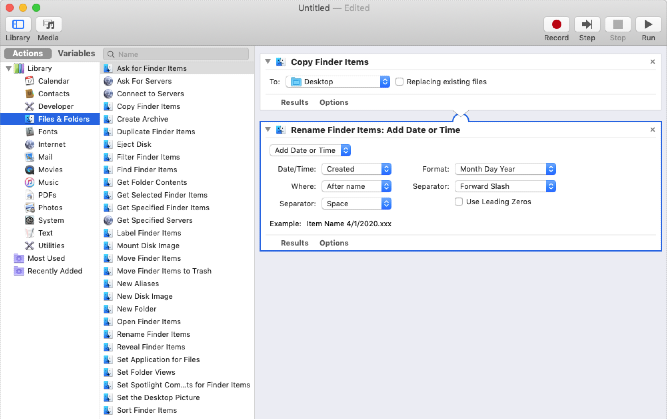
- #Automator mac function mac os
- #Automator mac function software
- #Automator mac function code
- #Automator mac function windows
Going the way of the transpiler, would be more about translating the AutoHotkey scripting language into a compiled equivalent into another programming language.
Red being more of a wildcard with future potential. Object Pascal also has some AutoHotkey-like automation tools, such as Simba (often use for making bots) and WinAutoKey (so far a bit limited), that can provide example code. C# probably being a bit more easier for those that know C++ to adapt to, where Object Pascal is as almost as close to the hardware as C++, but has more cross-platform friendly tools (Lazarus, FPC, etc.). Preferably one in a more cross-platform friendly language (in terms of tools available), thus the suggestion of C#, Object Pascal, or Red. would have many "landmines", that I believe a person or a group would have no choice but to create a new fork (think IronAHK in C# as an example) or transpiler.Ī person or group would likely have to focus on "translating" the AutoHotkey scripting language (not the C++ source code), and create a new interpreter. The present AutoHotkey C++ interpreter, installer, etc.
#Automator mac function windows
Though let's keep in mind that the Windows OS still holds a huge user base.
#Automator mac function code
And because they are so Windows centric, this can result in development choices that makes the AutoHotkey source code even harder to port over to a different OS. WINE has been discussed a number of times on the forums, example- (AHK installer under Linux/WINE).įrom that forum post about the installer, what we are getting is that the present AutoHotkey developers are very Windows centric and lack any motivation to create a cross-platform version of AutoHotkey.
#Automator mac function software
Open-source software that provides a Windows runtime enviornment for running applications on Linux and Macs. However, to make this a bit more complicated, there is WINE ( (software). Usually the issues presented about AutoHotkey being on a different OS has been the Windows APIs and Dlls, where the code needs to be different for that OS. The thinking that AutoHotkey code must be married to C++ and Windows, instead of thinking of AutoHotkey as it's own language that could use other interpreters, written in other programming languages. I think the other part of the issue is mindset. C#, Object Pascal, or Red would be good cross-platform candidates as well. I don't know how well Lua works out as a cross-platform language. It's interesting that this isn't being done for AutoHotkey. Many other programming languages make use of such. That sounds like a Transpiler or Source-to-Source Compiler.
#Automator mac function mac os
For instance have Lua "interpret" the AHK code by reading regular AHK code and then tranforming it into something Mac OS can understand. I've heard you can do this by translating AHK via another common language, such as Lua. These keyboard settings can be accessed in the “Keyboard” pane of System Preferences.Īnother method to turn off your Mac’s display, and hence put it to sleep, is by using a Terminal command.Is it possible to run the same AHK code written for Windows on a Mac by using a different software (e.g. Also, you may need to hold down the “Fn” key with the keyboard shortcuts above to put your Mac to sleep, as some keyboard’s F-keys are set to be standard function keys instead of Apple’s special features. Note: If you’re using an external third-party keyboard, you may need to use the specific key mapped to the Power/Eject button.

Your Mac should automatically go to sleep. On some systems though, you may need to hold down the power button for a moment (two to three seconds) and release it. To use this feature, simply press the power button, which should put your Mac to sleep. You should know that this power keyboard button is only available on newer Macs with built-in keyboards, and not on Apple’s wireless keyboards. The easiest way to put your Mac to sleep is by using the Power button.

We’ve detailed a few of these methods below, so check them out: Using the Power Button While useful, this method isn’t that efficient, and there are better and quicker options to put your Mac to sleep. One main option that you may already use is dimming the display completely using Apple’s function keys for increasing/reducing the display brightness.


 0 kommentar(er)
0 kommentar(er)
